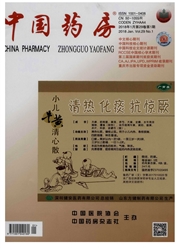

 中文摘要:
中文摘要:
目的:为推动乡镇卫生院进一步实施国家基本药物制度提供依据。方法:通过发放调查表获取黑龙江省“卫十一项目”地区所有乡镇卫生院国家基本药物制度实施前后的基本情况,并采用随机系统整群抽样方法抽取2008年和2012年全年中的4天的处方,进行统计和对比分析,评价用药合理性。结果:2009年与2013年两次调查分别回收乡镇卫生院机构调查表各40份,处方3 173张和4 197张。该地区2012年与2008年比较,平均执业(助理)医师比例增加了1.5%,平均床位数增加了4.6张,次均处方药品品种数由2.9种下降到1.7种,输液率由46.5%下降到30.6%,抗菌药物使用率由61.5%下降到40.0%,两种及以上抗菌药物联用率由18.9%下降到4.8%,激素使用率由11.9%下降到4.2%,抗菌药物/激素联用率由9.2%下降到2.8%;次均门诊和住院药品费用分别下降了19.1%和16.4%,差异均有统计学意义(P〈0.05)。结论:实施国家基本药物制度以后,黑龙江省“卫十一项目”地区乡镇卫生院用药合理性得到显著改善,特别是在处方药品数量、抗菌药物/激素联用率、激素使用率、药品费用等方面达到了政策目标;在输液率、抗菌药物使用率等方面虽也改善显著,但与政策目标还有一定差距;显著下降的次均药品费用并没有带来次均诊疗费用的下降,反而略有上升。
 英文摘要:
英文摘要:
OBJECTIVE: To provide basis for the further implementation of the national essential medicine system in township hospitals. METHODS: By issuing questionnaires, an investigation was made on the basic information of township hospitals imple- menting "Health XI project" in Heilongjiang Province before and after the implementation of the national essential medicine system. Prescriptions of 4 days in 2008 and 2012 were extracted, statistically compared and analyzed by using random system cluster sam- pling medication rationality was evaluated. RESULTS: 40 questionnaires and 3 173 prescriptions were recycled during the investiga- tion in 2009, and 40 questionnaires and 4 197 prescriptions were recycled in 2013. Compared with the township hospitals in project areas in 2008, the proportion of practice (assistant) physicians per township hospitals and the average number of beds were respec- tively increased by 1.5% and 4.6 in 2012. The average kind of prescription drugs was decreased from 2.9 kinds to 1.7 kinds, the us- age rate of infusion was decreased from 46.5% to 30.6%, antibiotics was decreased from 61.5% to 40.0%, two or more kinds anti- biotics was decreased from 18.9% to 4.8%, hormone was decreased from 11.9% to 4.2% and the rate of combined use of antibiot- ic and hormone was decreased from 9.2% to 2.8%; the drug expenditure of each outpatient service and hospitalization was respec- tively decreased 19.1% and 16.4 %. There were significant differences (P〈 0.05). CONCLUSIONS : After the implementation of na- tional essential medicine system, the medication rationality of township hospitals in project areas has made great improvement, es- pecially on the aspects of prescription drug number, the combined usage rate of antibiotic and hormone, the usage of hormone and the drug expense burden, which reaches the policy targets; although the infusion rate and the usage of antibiotic show great im- provements, there are still some gaps between the current situation and the policy targets; the obviou
 同期刊论文项目
同期刊论文项目
 同项目期刊论文
同项目期刊论文
 期刊信息
期刊信息
